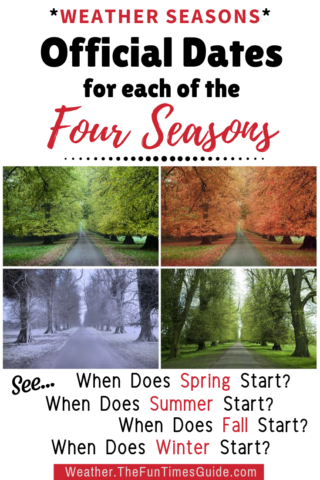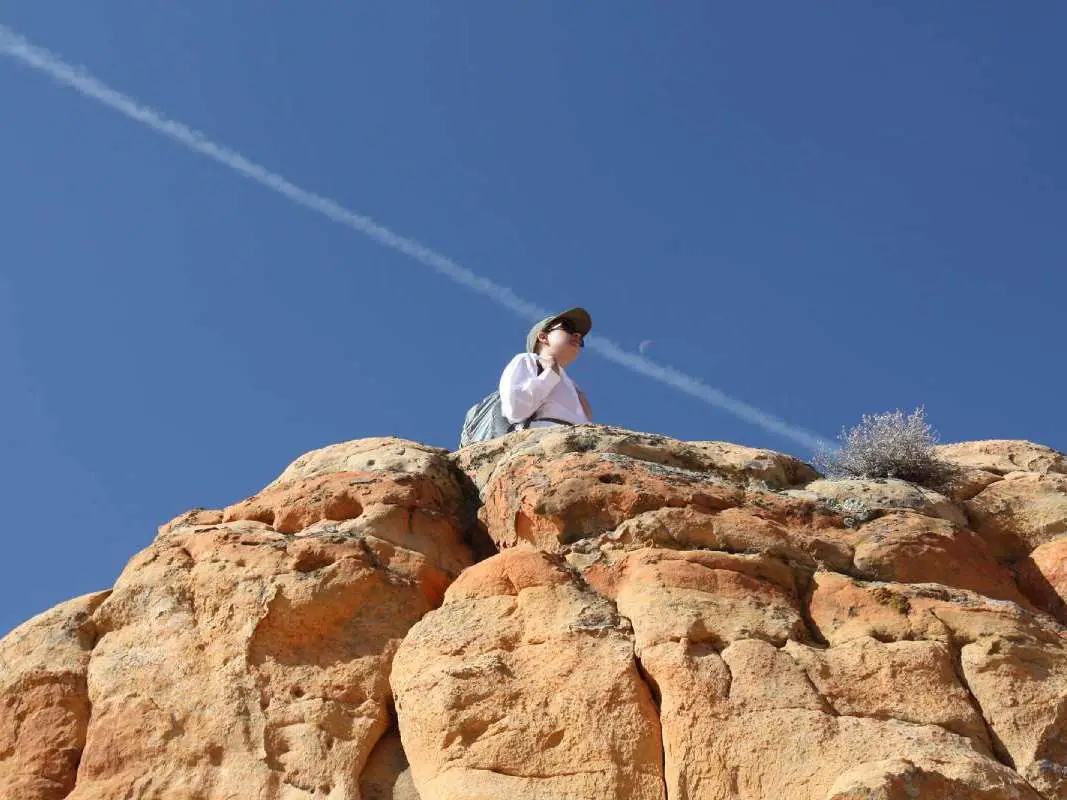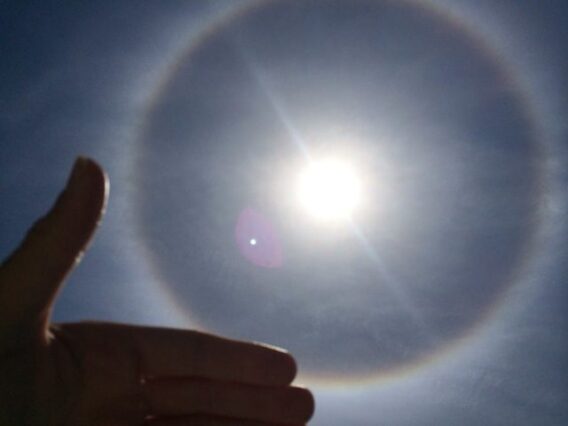Seasons and weather vary greatly, depending on where you live.
Even when the seasons start and end depends on whether you live north or south of the equator.
Have you ever wondered what the 4 weather seasons look like elsewhere in the United States — and how they’re different from where you live?
Growing up in Central Florida, my idea of a summer and winter is quite different than what it’s like for my family in Boston and Ohio.
I didn’t always get to travel very far when I was a kid. But now I travel a lot more and have been fortunate to experience the 4 seasons throughout much of the United States.
For example, I’ve noticed firsthand that winter in New York isn’t the same as winter in Orlando or Atlanta!
Observations like this recently got my wheels spinning about other regional differences during the 4 weather seasons — so I thought I’d share some fun facts about winter, spring, summer, and fall across the USA!
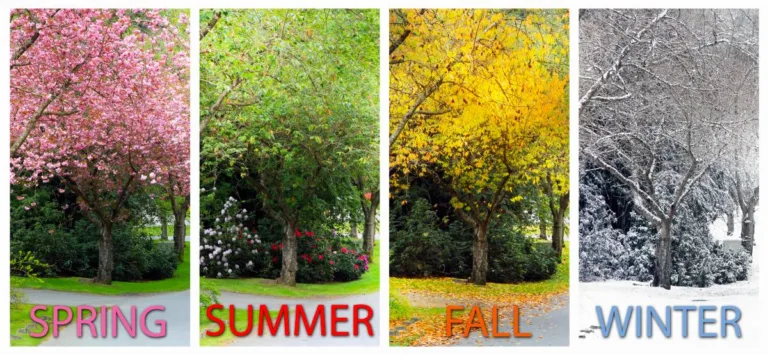
When Do Seasons Start And End?
According to astronomers…
The beginning and end of weather seasons are marked using the dates of equinoxes and solstices — and they are based on astronomical events:
- Winter begins on the winter solstice
- Spring begins on the spring equinox
- Summer begins on the summer solstice
- Autumn begins on the fall equinox
Here’s our favorite weatherman’s explanation of the summer solstice and winter solstice!
According to meteorologists…
The seasons begin on the first day of the months that include the equinoxes and solstices mentioned above — and they are based on average temperatures:
- Winter is December 1 to February 28 (or February 29 during a leap year)
- Spring is March 1 to May 31
- Summer is June 1 to August 31
- Autumn is September 1 to November 30
Northern Hemisphere Weather Seasons
On the calendar, everyone in the Northern Hemisphere experiences the seasons of winter, spring, summer, and fall at the same time.
The Northern Hemisphere is the part of the planet that is north of the equator. It has about 90% of world’s population and most of the world’s land. All of North America and Europe are in the Northern Hemisphere. Most of Asia, two-thirds of Africa and 10% of South America are also in this hemisphere. The 3 largest countries by population — China, India, and the United States — are in the Northern Hemisphere.
~ Source
And… because of Earth’s tilt, when it’s winter in the Northern Hemisphere, it’s summer in the Southern Hemisphere. When it’s fall here, it’s spring there. And so on.
My family in the northern parts of the United States mark the first day of fall on the same day as I do — but while they’re beginning to see the first brisk days of fall blow in, I’m still sweltering in the Florida heat.
Here’s why:
Anyone who’s seen different parts of the United States throughout the year knows that the same season can look very different in two different parts of the country at the same time.
Okay, now here’s what the 4 weather seasons are like in each of the 4 regions of the Continental United States…
WINTER: Chilly & Wet With A Chance Of Snowballs
Generally speaking, winter takes place in December, January, and February.
Most folks think of winter as a chilly, snowy time of year. And for most Americans, it is. But winter doesn’t always bring snow and icy conditions to everyone.
Folks in the northern climates are used to seeing many inches (even feet) of snow. But Atlantans and Houstonians may be lucky if they see a light dusting of the white stuff during any given winter. This goes to show the 4 weather seasons are different everywhere — including winter!
New England & Mid Atlantic
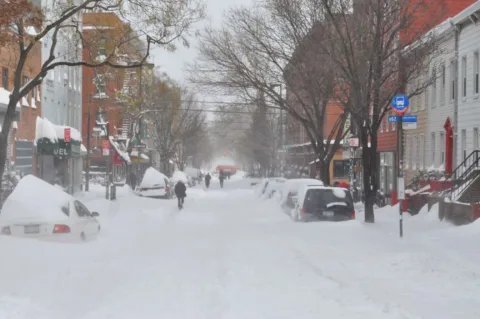
People living in New England and the Mid-Atlantic states generally experience several blizzards over the course of a typical winter. This can bring whiteout conditions, dangerous roads, and even sustained blackouts. While a blizzard may blanket the northeast and mountain regions extending south into the Carolinas with snow, people living closer to the shore in places like Virginia or the Carolinas may see only a dusting of snow. Sometimes a blizzard for those closer to the shore means mixed precipitation or even just cold rain.
The Southeast & Deep South
Winter sometimes brings the promise of a snowy Christmas morning to people in parts of Tennessee, Arkansas, and Kentucky. But folks in Georgia, Mississippi, Alabama, and Florida can usually only dream of a white Christmas. Snow and ice are scant in the southernmost regions of the Deep South. Florida has seen only a handful of light snowfalls over the course of the past few decades. Winter in Florida, lower Georgia, and the coastal regions of Alabama, Mississippi, and Louisiana brings brief cold snaps, short freezes, and generally mild winter weather.
Midwest & Plains
The Midwest sees some of the largest annual temperature swings of anyplace in the United States. In the winter, temperatures can plunge well below zero degrees. Massive snow and ice storms can ravage states spanning from Ohio to the eastern Rockies — and from Minnesota down to Texas. Snowstorms often amass and unleash their wintry rage in the Midwest before blowing through northeastward as aptly named nor’easters.
Pacific & Rocky Mountains
The Pacific Coast often sees relatively mild winters and only light snowfall along the coast from northern California up through Seattle — rarely farther south. Meanwhile, winter in the Rockies generally promises long periods of snow coverage. This is one reason why ski resorts in the mountains of California, Colorado, and elsewhere in the West are so profitable. Wintery conditions sometimes begin in the mountains as early as September and last as late as May or even June.
SPRING: April Showers, May Flowers & June Pollen
Springtime signals Mother Nature’s awakening from her wintery slumber. Blooms of all types color the American landscape from coast to coast — but in varying degrees and at different times. Of all 4 weather seasons, spring is perhaps the most anticipated by folks who live in the colder climates.
New England & Mid Atlantic

They say March comes in like a lion and goes out like a lamb. That old idiom refers to the blizzards and wintry conditions that usually linger into the first weeks of March. Toward the end of the month, frosts ease up and warmer weather settles in. By April, tulips and lilies are popping out of the ground, while lilacs and hydrangeas are in full bloom.
The Southeast & Deep South
Harsh winters dissipate more slowly in the Northeast, but the Southeast warms up quite well by the time spring appears on the calendar. Frosts in the southern states are rather uncommon after February or early March — especially in the southernmost states and coastal regions. Colorful magnolias and crepe myrtles showcase their vibrant hues during March and April. Meanwhile other trees such as oak and maple are in full flourish with bright-green new growth highlighting the pathways of tree-lined streets.
Midwest & Plains
Wildflowers paint the vast landscapes while rolling hills of trees exude flowery pastels and rich greens. Spring can bring chills in March or April, but by May and June warm weather has returned with nearly summery heat. This transition from winter to spring is ushered in by terrible storms — with April and May unleashing rounds of dangerous tornadoes. Turbulent and often tornadic weather spanning from March into June give this region the notorious moniker Tornado Alley.
Pacific & Rocky Mountains
Spring starts early in the desert Southwest, but in the more mountainous regions flowers, grasses, and trees begin showing their springy color in April, May, and June. Frosts in the Pacific coastal region are unusual going into late spring — and the weather turns mild to warm in March and April. This opens the door for a vibrant array of spring flowers and blooming plants and trees.
SUMMER: Hot & Heavy Humidity
Summer is the hottest time of the year. For many Americans, summertime signals the arrival of beach weather — whether that means a weekend down the shore on Cape Cod or New Jersey, taking in the rays on the white sands of Florida, riding waves along the Pacific Coast, or camping down near a favorite lake or pond.
New England & Mid Atlantic
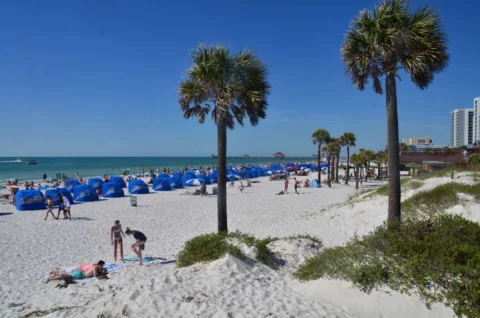
Trees and plants are in full bloom and warm breezes blow. Even along the northernmost points of the Atlantic seaboard, temperatures will regularly rise well into the 80s and 90s. Places like New York City, Philadelphia, and Washington, D.C., sometimes flirt with (or even surpass) the 100-degree mark. Summer storms form as humid air and convection fire up thunderheads — causing instant, pop-up lightning storms along local sea breeze and continental wind boundaries.
The Southeast & Deep South
It’s really hot, hot, hot in the South during summertime. Places like Atlanta, Birmingham, and Memphis can top 100 degrees. Closer to the Gulf and Atlantic Ocean, afternoon temperatures are generally a little closer to 90 or 95 degrees. Meanwhile, peninsular Florida often notches some of the “cooler” summertime temperatures in the region — but that’s only because deeply humid air keeps temperatures from jumping up past 90 to 92 degrees, with afternoon thunderstorms cooling things down afterward. During the late summertime, tropical storms and hurricanes that form in the Atlantic sometimes make landfall in the coastal Southeast. These tropical systems bring strong winds and torrential rains to near-shore communities throughout the South.
Midwest & Plains
America’s heartland get pretty warm during the summertime. Sweltering heat into the 90s and 100s reaches from Texas up through Minnesota. Sometimes a passing front brings temporary relief from the heat, but usually summertime in the middle of the United States bakes the region’s grain fields and just about everything else, too. The tornado threat is usually much lower in the summer than in the spring. However, an occasional tornado will still sometimes spin up during storms that form over the vast flatlands of the Midwest and the Plains during June, July, and August.
Pacific & Rocky Mountains
Looking for cool summer weather? One of the best places to seek brisker summer temps is along the Pacific Coast, which features some of the most moderate year-round temperatures anywhere in the country. Summertime is (relatively) cool along much of coastal California and places north along the West Coast, but it can get fiery hot in other Pacific communities. And unfortunately I’m not talking about heating from the sun. Rather, August and September mark the peak of wildfire season. California most especially deals with the brunt of wildfires. They often ravage countless acres of forests, killing thousands of animals, destroying homes and — as we saw during the devastating “Camp Fire” that ravaged Butte County, California — sometimes extinguishing human life, too.
AUTUMN: The Most Colorful Of The 4 Seasons
Fall brings cooler weather, colorful trees, and — yes — the flavor of pumpkin spice to everything from coffee and beer to yogurt and even hummus. But while national coffee chains unveil their PSLs (pumpkin spice lattes) from coast to coast by Labor Day, Mother Nature’s take on autumn looks very different in the 4 corners of the country. Early snowfall sometimes whitens parts of the Rockies — while fall color filters from north to south in places like the Plains, the Appalachians, and New England.
New England & Mid Atlantic
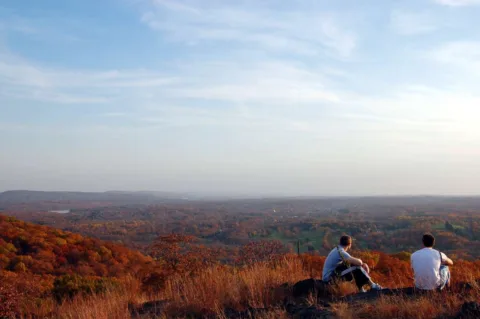
There’s perhaps no more popular place to go leaf peeping in September and October than New England and the Mid Atlantic states. Vermont, New Hampshire, and Maine see the first colorful hints of fall as early as August, with peak color usually going off like fireworks in late September. Color spreads southward and toward the eastern shorelines by October. Meanwhile, in the mountains of Virginia and the Carolinas, peak color comes in during mid October. Cities such as Asheville, North Carolina and Charlottesville, Virginia, draw droves of leaf peeping tourists. It’s not unusual for ice or a dusting of snow in some mountain communities in late October or early November.
The Southeast & Deep South
The changing of the calendar from summer to fall usually comes with little to no noticeable difference in temperature in the South. The passage of the season’s first significant cold fronts in late September and into October bring progressively and significantly cooler weather. By Halloween, even normally hot southern cities such as Atlanta and Tampa are enjoying cool weather. Fall color won’t be pronounced in most Deep South communities until October, with the region’s last hints of fall color peaking in northern and parts of central Florida during early November.
Midwest & Plains
The nation’s mid section sees cool weather plummet from Canada beginning in late August or early September, with southern portions of the region, such as Oklahoma City and Dallas, receiving much cooler weather by October. The Midwest and the Plains aren’t often advertised as being popular places to spot fall color. But there are many wonderful spots all throughout the Midwest and the Plains where autumn hues paint entire vistas with pops of beautiful purple, red, orange, and yellow.
Pacific & Rocky Mountains
Ski resorts in places near Denver and Boise start gearing up by September. That’s when the first snowfalls sometimes blanket the hills. Closer to the Pacific, fall brings the West Coast its own vibrant brand of autumn in the mountains and valleys. California’s wet season is just cranking up around October, putting a damper on wildfires. But unfortunately this increases the risk of mudslides. Meanwhile, the wet season along other parts of the Pacific delivers snow in the upper reaches of the mountains. The Sierra Nevadas, Cascades, and other high peaks will be capped in beautiful blankets of white.
The Bottom Line
Some people in the north like to joke that 4 seasons just mean 4 different amount of snowfall.
In Florida, there’s an untrue belief that the leaves there never change color unless they’re turning brown.
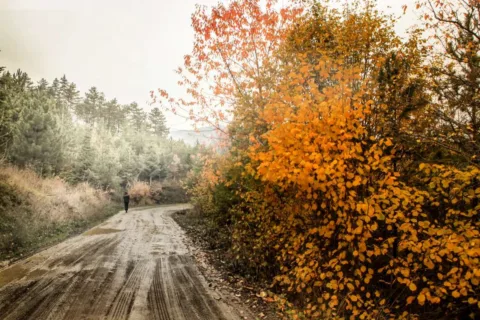
In the Rockies, ski resorts are almost always busy — if not with skiing guests then getting ready for the next ski season.
But every part of the United States has its own version of the 4 weather seasons — and each region has its own brand of seasonal beauty.
Still, if you’re wanting a change, you might consider touring other parts of the country to see what the seasons look like there.
For example, I’ve taken many trips to New England and the Appalachians to see fall colors there. And I’m hoping to get to the Pacific or the Rockies someday to hit the slopes (…the bunny slopes, at least).
Live in the middle of the Plains and want to enjoy a summer at the beach? Travel to California!
Tired of shoveling winter snow? Florida has plenty of wintertime sunshine — none of which you’ll need to shovel!
Get out and see the seasonal beauty this vast country has to offer. I can pretty much guarantee, you won’t be disappointed by the exciting sights and smells each season has to bring no matter where you’re traveling.
Like this post? Save it to read again later… or share with others on Pinterest!
I'm a weather geek from Florida who's been studying meteorology and watching weather patterns for years! I enjoy sharing little-known facts and fun stuff about the weather. I especially like sharing interesting details about weather events and conditions that can affect you… and how to prepare for Mother Nature's ever-changing weather patterns.

